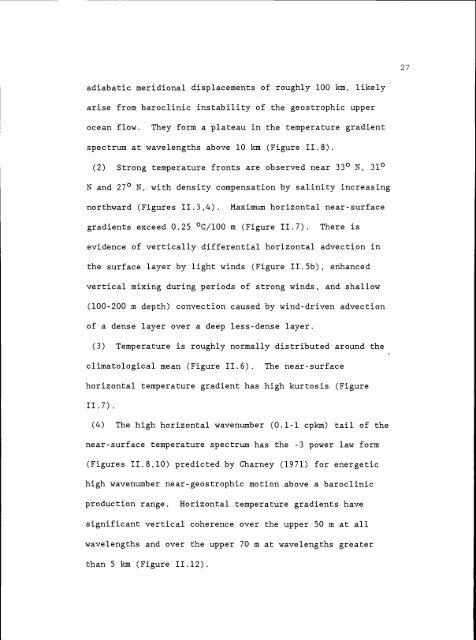Observations and Modelling of Fronts and Frontogenesis
Observations and Modelling of Fronts and Frontogenesis
Observations and Modelling of Fronts and Frontogenesis
You also want an ePaper? Increase the reach of your titles
YUMPU automatically turns print PDFs into web optimized ePapers that Google loves.
adiabatic meridional displacements <strong>of</strong> roughly 100 km, likely<br />
arise from baroclinic instability <strong>of</strong> the geostrophic upper<br />
ocean flow. They form a plateau in the temperature gradient<br />
spectrum at wavelengths above 10 km (Figure 11.8).<br />
(2) Strong temperature fronts are observed near 330 N, 310<br />
N <strong>and</strong> 27° N, with density compensation by salinity increasing<br />
northward (Figures 11.3,4). Maximum horizontal near-surface<br />
gradients exceed 0.25 °C/l00 m (Figure 11.7). There is<br />
evidence <strong>of</strong> vertically differential horizontal advection in<br />
the surface layer by light winds (Figure II.5b), enhanced<br />
vertical mixing during periods <strong>of</strong> strong winds, <strong>and</strong> shallow<br />
(100-200 m depth) convection caused by wind-driven advection<br />
<strong>of</strong> a dense layer over a deep less-dense layer.<br />
(3) Temperature is roughly normally distributed around the<br />
climatological mean (Figure 11.6). The near-surface<br />
horizontal temperature gradient has high kurtosis (Figure<br />
II . 7)<br />
(4) The high horizontal wavenumber (0.1-1 cpkm) tail <strong>of</strong> the<br />
near-surface temperature spectrum has the -3 power law form<br />
(Figures 11.8,10) predicted by Charney (1971) for energetic<br />
high wavenumber near-geostrophic motion above a baroclinic<br />
production range. Horizontal temperature gradients have<br />
significant vertical coherence over the upper 50 m at all<br />
wavelengths <strong>and</strong> over the upper 70 m at wavelengths greater<br />
than 5 km (Figure 11.12).<br />
27















